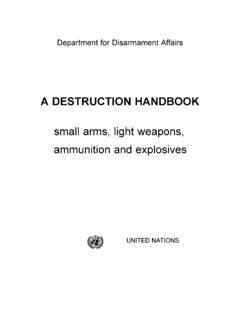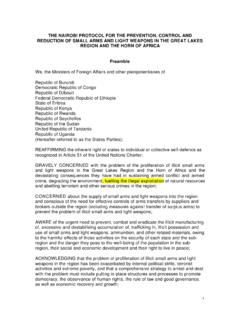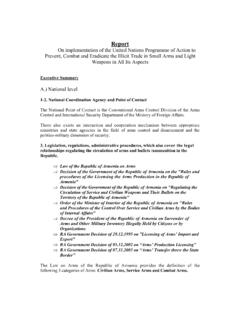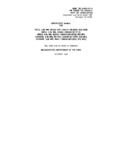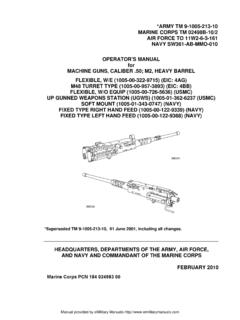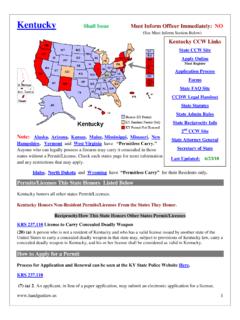Transcription of Ammunition and Explosives Storage and Safety
1 South Eastern and Eastern Europe Clearinghouse for the Control of Small Arms and Light weapons (SEESAC) RMDS/G 5th Edition 2007-02-20 Ammunition and Explosives Storage and Safety Head, SEESAC, UNDP Belgrade, Internacionalnih Brigada 56, 11000 Belgrade, Serbia E-mail: Telephone: (+381) (11) 344 63 53 Fax: (+381) (11) 344 63 56 RMDS/G 4th Edition (2006-07-20) i Warning This document is current with effect from the date shown on the cover page. As the Regional Micro-Disarmament Standards/Guidelines (RMDS/G) are subject to regular review and revision, users should regularly consult the RMDS/G project website in order to verify their current status: Copyright notice This document is a South Eastern and Eastern Europe Regional Micro-Disarmament Standard/Guideline (RMDS/G) and is copyright protected by UNDP.
2 Neither this document, nor any extract from it, may be reproduced, stored or transmitted in any form, or by any means, for any other purpose without prior written permission from SEESAC, acting on behalf of UNDP. This document is not to be sold. Head, SEESAC, UNDP Belgrade, Internacionalnih Brigada 56 11000 Belgrade, Serbia E-mail: Telephone: (+381) (11) 344 6353 Fax: (+381) (11) 344 6356 SEESAC 2006 All rights reserved RMDS/G 4th Edition (2006-07-20) ii Contents Contents .. ii Foreword .. iv v Ammunition and Explosives Storage and 1 Scope ..1 2 3 Terms and 4 General requirements ..2 5 International legislation ..2 Movement of Explosives by road .. 2 Storage of Ammunition and 2 6 Environmental requirements ..2 7 Storage requirements ..3 Storage 3 Warning signs and 3 Fire prevention.
3 3 Table of Safety distances .. 3 Indoor 3 8 Transportation General .. 3 Passengers .. 3 Transporting detonators and Explosives .. 3 Special 3 9 Handling ..4 10 Inert, drill, instructional or replica mines and 11 Physical security ..4 12 Areas of National SALW authority .. 4 SALW Control organisation .. 5 SALW Control workers .. 5 Regional organizations .. 5 SEESAC .. 5 Annex A (Informative) References ..6 Annex B (Informative) Terms and Annex C (Informative) Bibliography ..Error! Bookmark not defined. Annex D (Informative) General requirements for the construction of Permanent structure ..12 Portable or mobile magazine ..12 RMDS/G 4th Edition (2006-07-20) iii Day box ..13 Detonator transport container ..13 Annex E (Informative) Fire prevention ..15 Annex F (Informative) Table of distances for the Storage of explosive materials.
4 17 Annex G (Normative) Hazard classification Hazard Compatibility groups ..19 Hazard Classification Code ..19 Appendix 1 to Annex G (Informative) Ammunition hazard Appendix 2 to Annex G (Informative) Ammunition compatibility Annex H (Normative) Inert, drill, instructional or replica Ammunition and General ..23 Storage ..23 Movement ..24 Breakdown of Ammunition and Explosives ..24 Marking of inert or drill Ammunition and Registration and accounting of inert or drill Ammunition and Free From Explosive (FFE) certification ..25 RMDS/G 4th Edition (2006-07-20) iv Foreword On 08 May 2003 the development of regional micro-disarmament1 standards and guidelines was discussed during the RACVIAC sponsored seminar on SALW - A year after Implementation of the Stability Pact Plan . The consensus was that such standards and guidelines were desirable, and SEESAC agreed to develop a framework and then take responsibility for the future development of regional standards.
5 It was agreed RMDS/G would be designed to support the work at the operational level, and would go further than the more generic best practice documents currently available. After a wide-ranging discussion between stakeholders as to the status of RMDS/G it has been agreed that the term standards will refer to the technical issues, whilst guidelines will apply to programme issues. This RMDS/G 2 reflects the development of operational procedures, practices and norms, which have occurred over the past four years in the area of Small Arms and Light weapons (SALW)3 control. Best operational practices have been identified and reviewed from within the region and beyond, and included as appropriate within this RMDS/G. SEESAC has a mandate under the Stability Pact Regional Implementation Plan to fulfil, among others, operational objectives of 1) sharing information on and enhancing co-operation in the establishment and implementation of SALW control and reduction programmes and approaches among regional actors; and 2) providing linkage and co-ordination with the other relevant regional initiatives.
6 The development of RMDS/G is one means of fulfilling that mandate. The work of preparing, reviewing and revising these standards and guidelines is conducted by SEESAC, with the support of international, governmental and non-governmental organisations and consultants. The latest version of each standard, together with background information on the development work, can be found at RMDS/G will be reviewed at least every three years to reflect developing SALW control norms and practices, and to incorporate changes to international regulations and requirements. The latest review was conducted on 01 March 2006, which has reflected the development of the UN Integrated Disarmament, Demobilization and Reintegration Standards (IDDRS) , which include RMDS/G as a normative reference in the Disarmament and the SALW Control modules.
7 1 Defined as: The monitoring, collection, control and final disposal of small arms, related Ammunition and Explosives and light weapons of combatants and often also of the civilian population. It includes the development of responsible weapons and Ammunition management programmes . Often used interchangeably with SALW control in the past, but SALW Control is now the recognised terminology. The term Micro-Disarmament has only been used here to ensure consistency of the RMDS/G concept, rather than renaming the standards. 2 The layout and format of RMDS/G are based on the highly successful International Mine Action Standards (IMAS). The cooperation of the UN Mine Action Service (UNMAS) is acknowledged by SEESAC during the development of RMDS/G.
8 3 There is no agreed international definition of SALW. For the purposes of RMDS/G the following definition will apply: All lethal conventional munitions that can be carried by an individual combatant or a light vehicle, that also do not require a substantial logistic and maintenance capability RMDS/G 4th Edition (2006-07-20) v Introduction The need to reduce risk and to provide a safe working environment are fundamental principles of SALW Control operations. Risk reduction involves a combination of safe working practices and operating procedures, effective supervision and control, appropriate education and training, equipment of inherently safe design, and the provision of effective personal protective equipment and clothing. The provision of a safe working environment includes the safe Storage , transportation and handling of Explosives and explosive materials.
9 This requires appropriate Storage facilities, equipment and vehicles to be made available, and for national SALW authorities and SALW Control organisations to develop and maintain appropriate policy and procedures. Where existing national government regulations differ from those contained in RMDS/G, the more stringent requirement should be met. This standard 4 provides national SALW authorities and SALW Control organisations with guidance on the safe Storage , transportation and handling of Explosives and explosive materials. Specifications for the Storage of Explosives and Safety distances are those provided by NATO Allied Ammunition Storage and Transport Principles (AASPT) and are consistent with the United Nations' Draft Ammunition and Explosives Regulations. These specifications should not normally be reduced without the advice of a professionally qualified Explosives engineer.
10 4 This RMDS/G is also based on IMAS RMDS/G 4th Edition (2006-07-20) 1 Ammunition and Explosives Storage and Safety 1 Scope This RMDS/G provides specifications and guidelines for the safe Storage , transportation and handling of Ammunition and Explosives that are either: 1) recovered during SALW collection operations; 2) awaiting destruction; or 3) are surplus in Storage . In this standard, the term ' Explosives ' is used to refer to both Explosives and explosive materials, unless stated otherwise in the text. (See Clause 3 below). 2 References A list of normative references is given in Annex A. Normative references are important documents to which reference is made in this standard, and which form part of the provisions of this standard. 3 Terms and definitions A list of terms and definitions used in this standard is given in Annex B.
